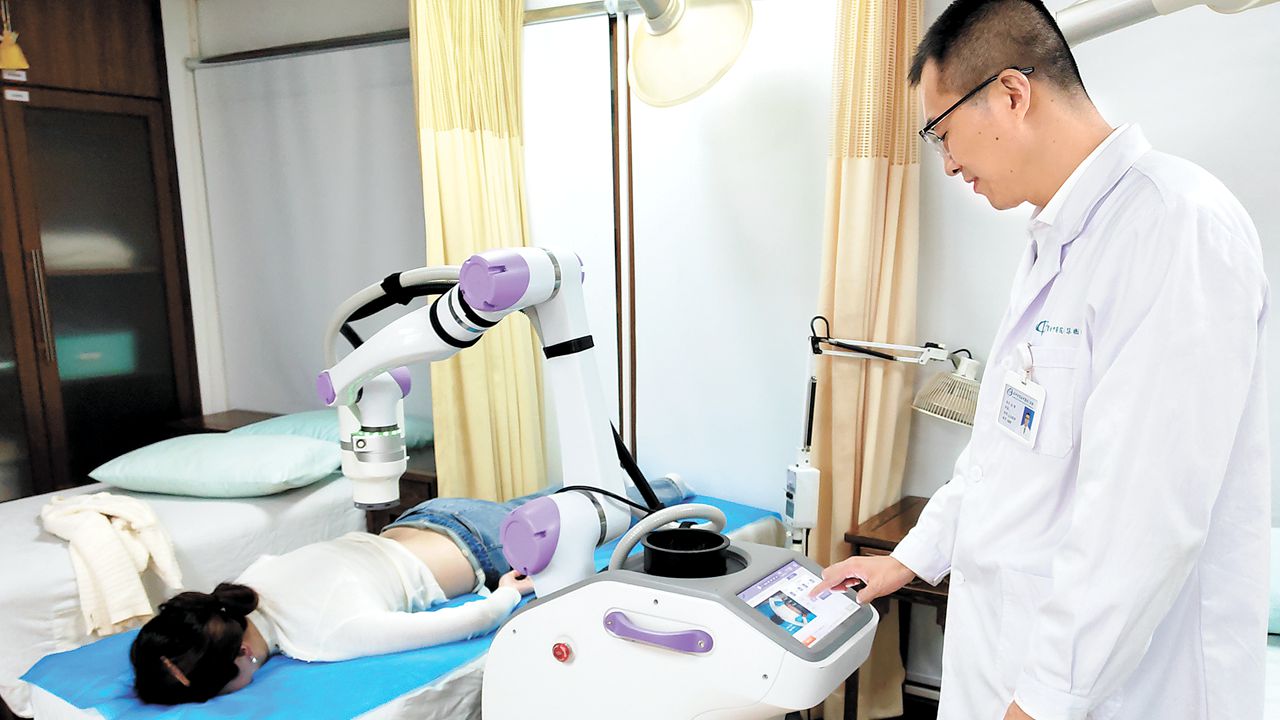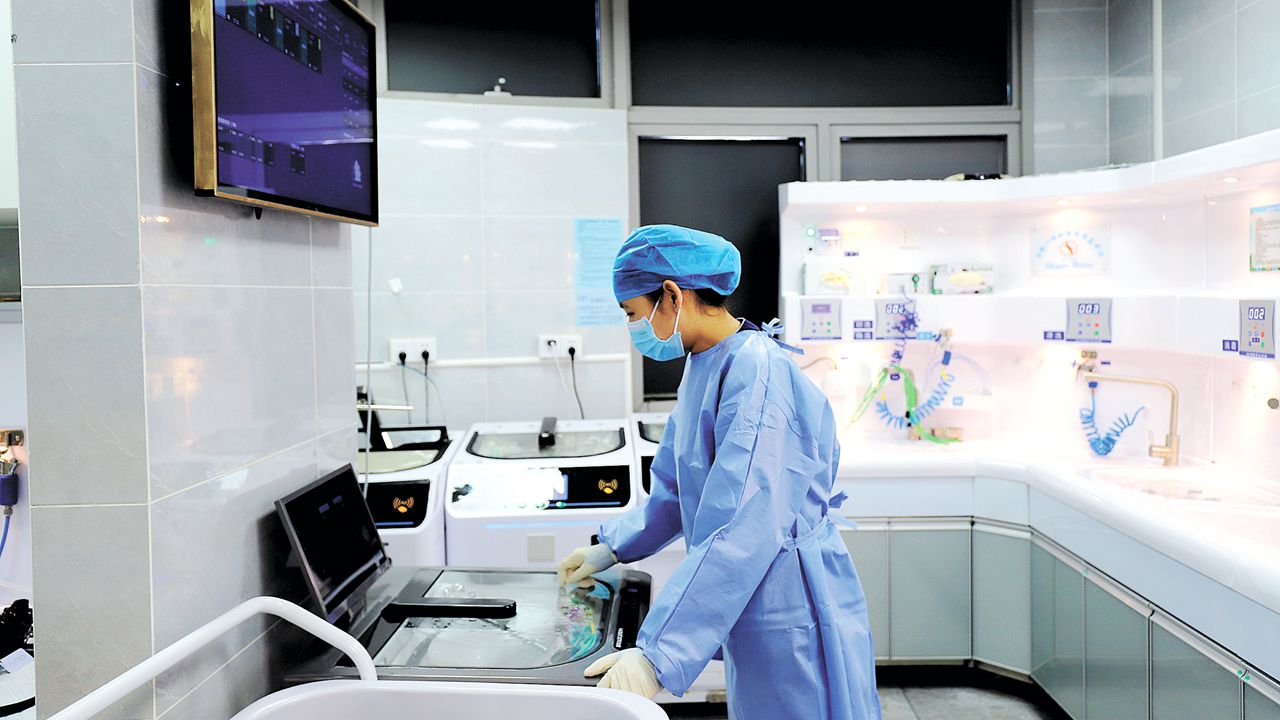AI adoption transforms SZ's medical services
Writer: Liu Minxia | Editor: Zhang Zhiqing | From: original | Updated: 2025-04-03
In Shenzhen, a city renowned for its rapid technological advancements, artificial intelligence (AI) and robotics are reshaping health care at an unprecedented pace. From robotic acupuncturists to AI-powered critical care diagnostics, the city is pioneering a new era in which doctors collaborate with their "silicon-based colleagues," enhancing efficiency, accuracy, and the overall patient experience.

Medical staff read patient data generated by an AI model at Peking University Shenzhen Hospital's intensive care unit. Photos courtesy of the hospital
Preliminary statistics indicate that nearly 450 AI-powered products are currently in use across Shenzhen’s hospitals, spanning diagnostics, surgery, and patient management.
At Shenzhen Bao'an Traditional Chinese Medicine Hospital, 36-year-old patient Wang Jing receives moxibustion therapy — not from a human practitioner, but from a robot. Equipped with visual recognition and deep learning algorithms, this machine, developed by the hospital in partnership with a local robotics company, can precisely identify acupoints, intelligently control temperature for treatment safety, and apply tailored techniques based on patients' symptoms.
“It’s effective and avoids any awkwardness,” Wang said, emphasizing how the robot alleviates common discomfort associated with doctor-patient interactions.
Meanwhile, at Peking University Shenzhen Hospital, robots now handle endoscope cleaning — a task that traditionally required five nurses, now reduced to just 1.5 staffing positions. This AI-driven system, certified in late 2024, was developed by the hospital with support from Broadcare Robot, a Longgang-based robotics company.
In diagnostics, AI models like DeepSeek and Tencent’s Hunyuan assist patients at Shenzhen Third People’s Hospital by translating complex medical terminology into plain language and recommending personalized health plans. The Luohu Hospital Group has also deployed Tencent AI models to provide real-time diagnostic support for doctors.
The rapid integration of AI is particularly noteworthy in critical care settings. A groundbreaking collaboration between Shenzhen Mindray Bio-Medical Electronics Co. and Tencent has resulted in the development of a large-scale medical AI model deployed at Peking University Shenzhen Hospital's intensive care units (ICUs). This system analyzes patient data in just five seconds and autonomously drafts medical records in one minute, allowing doctors to make quicker and more informed decisions in ICUs, where rapid decision-making can be lifesaving.

A patient receives moxibustion therapy from a robot at Shenzhen Bao'an Traditional Chinese Medicine Hospital.
At Shenzhen People's Hospital, AI has dramatically transformed the pathological diagnosis process. The introduction of AI has reduced cervical smear diagnosis times from two days to same-day results, achieving a remarkable 99% accuracy in negative cases. This allows pathologists to focus on more complex cases. Similarly, prenatal ultrasound AI at Shenzhen Maternity & Child Healthcare Hospital has cut scan times from 30 minutes to just 10, while improving standardization by 30%.
The influence of AI extends beyond hospitals into community care. Fuwai Hospital Chinese Academy of Medical Sciences Shenzhen provides AI-assisted services such as online consultations and chronic disease prescription refills, enabling patients to access health care services conveniently from home. Huatuo GPT, the first large-scale health care model capable of passing medical examinations, is being commissioned as a digital family doctor in Longgang District.
As a front-runner in both artificial intelligence and high-end medical device development, Shenzhen possesses unique advantages for advancing AI in health care. Collaborations between health care providers and technology companies facilitate rapid advancements and upgrades in AI deployment within clinical settings. In testing phases for the endoscope cleaning robots at Peking University Shenzhen Hospital, nursing staff expressed concerns about the robots’ lack of tactile feedback. Modifications were swiftly implemented to enhance functionality.

A nurse operates an endoscope cleaning robot at Peking University Shenzhen Hospital.
"During testing, we noticed the robots couldn't detect blockages or air leaks in endoscope channels like our skilled nurses," said Li Bei, head nurse of the hospital's gastrointestinal surgery department. "After engaging with the developing company, engineers promptly upgraded the robot with microcrystalline pressure sensors, allowing it to automatically identify abnormalities in endoscope channels during cleaning.”
"The prenatal ultrasound AI would have been much more challenging to implement successfully anywhere but Shenzhen," said Li Shengli, director of ultrasound medicine at Shenzhen Maternity & Child Healthcare Hospital.
The city hosts one of the nation's most concentrated clusters of high-end medical device manufacturers, accounting for 75% of Shenzhen's total medical equipment industry output. Established industry giants like Mindray and BGI anchor the sector, while smaller innovators are pushing boundaries in medical imaging, in-vitro diagnostics, and surgical robotics.
Simultaneously, Shenzhen is accelerating its transformation into an AI pioneer city. Tech titans like Huawei and Tencent are driving foundational breakthroughs, while robotics leaders such as UBTECH collaborate with smaller firms to develop products catering to various needs.
As part of its ambition to be a leading city for medical AI innovation, Shenzhen’s health commission aims to deeply integrate AI into more health care sectors by the end of 2027, ultimately establishing two to three fully AI-powered hospitals and one to two AI health care demonstration zones by that time.